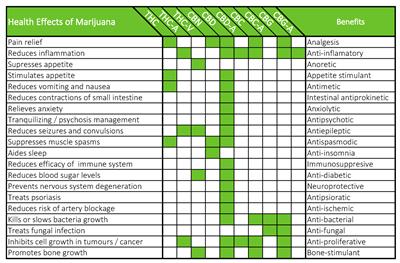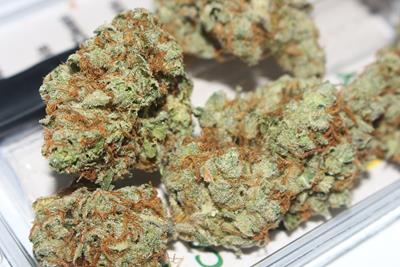
Saturday June 12, 2021
By Trevor Ross
Reviewed By Joshua Hooten, M.D. on Friday May 6, 2022
 Health/Science
Health/Science
For decades, British septuagenarian Jo Cameron has been the subject of medical scrutiny as she is apparently impervious to pain or fear, and the cuts and burns she commonly suffers actually heal more quickly than average. This mystery may have finally been solved after decades of cannabis research-led doctors to an unlikely source: her endocannabinoid system. Ms. Cameron has a minor mutation resulting in“significantly elevated” concentrations of anandamide, which doctors now believe is responsible for a life led without pain or fear.
Anandamide, also known as “the bliss molecule,” is an endocannabinoid and neurotransmitter produced by the body. When it binds with protein receptors in cells, it triggers physiological responses to reduce inflammation, alleviate stress, and more. For this reason, it derives its name from the Sanskrit ananda, meaning “joy” or “bliss.” Its discovery in 1992 was a moon landing moment that validated years of research, often conducted at the fringe of the scientific community, and under political and financial duress.
Research and Discovery of Anandamide
Federal restriction and penalties for even possessing cannabis arose in 1937, and increased through the next two decades before culminating in the Controlled Substances Act of 1970, signed by Richard Nixon, which declared that cannabis had “no currently accepted medical use and a high potential for abuse.” This sentence from the federal government largely slammed the door on further cannabis research, vilifying cannabis to a degree we are still recovering from.
Thankfully, research continued in other countries, carrying us to the landscape as we see it now. And while our knowledge of the endocannabinoid system is not yet complete, the discovery of anandamide is a victory for past researchers and provides a foundation for the future of cannabinoid therapy.

THC, the psychoactive compound in marijuana, was discovered in 1940 by American Chemist Roger Adams, and was first isolated by Israeli chemist Dr. Raphael Mechoulam in 1964. But while the effects of THC were infamous by that time, the pharmacokinetics – how the drug was absorbed and distributed by the body – was still unclear. We knew that THC interacted with the body, and we could see the effects, but we couldn’t tell where it plugged in. It wasn’t until 1988 that Dr. W. A. Devane and his team observed the first cannabinoid receptor in the brain of a rat.
The discovery of a physical system designed to communicate with cannabinoids sent a thousand proverbial ships racing to the new world. Researchers knew evolution would not sustain a system for thousands of years if it was not being regularly utilized.
The only logical conclusion was that our bodies created their own cannabis-like compounds to trigger those same receptors.
The search for the presumed endocannabinoid system celebrated an unexpected success in 1990 when Dr. Lisa Matsudo and her colleagues were cloning a superfamily of cell receptors (cell receptors with similar, but not identical, shapes), and they found a type that no drug or compound would bind with. Finally, Dr. Matsudo wondered if it would bind with cannabinoids. They did, and Dr. Matsudo and her team successfully cloned a CB receptor.
Finally, on March 24, 1992, Lumír Hanuš, working with Dr. Devane, and in conjunction with Dr. Mechoulum discovered anandamide, and with it, proof that the body created its own cannabinoid compounds.
What Does Anandamide Do in the Body?
Anandamide binds with CB receptors to offer relief from pain and inflammation, and to mitigate anxiety. Many of its effects are similar to those of THC, and this is partially because they share a very similar chemical structure.
In fact, the fabled “Runner’s High” may actually be a product of the endocannabinoid system. For years, our best guess at the euphoric feelings resulting from exercise was a rush of endorphins, which are peptides that bind with the same receptors as opioids to suppress feelings of pain. However, the relief from anxiety and elevated mood that also accompany a great workout appear to result from increased levels of anandamide, which also result from exercise. There is even evidence that anandamide can increase neurogenesis (the growth of new brain tissue) in embryonic cells, and other cannabinoids can increase neurogenesis in adults.

Anandamide usually has a short life in the body as it is broken down by the enzyme fatty acid amide hydrolase (FAAH) – unless it’s not. Remember Jo Cameron, who had sustained elevated levels of anandamide in her blood? Her FAAH enzymes are mutated. This mutation prevents them from breaking down anandamide. Hence, the process is slowed down and anandamide concentrations are built up in her body.
Remember that anandamide increases embryonic cell neurogenesis? Well, Jo’s FAAH were mutated when she was an embryo. Which could have caused her to be much more sensitive throughout life. So, Jo Cameron would be more sensitive to anandamide and have higher concentrations.
The theory that increased concentration of anandamide reduces her pain and anxiety is supported by a 2015 study finding that inhibiting FAAH enzymes made rats less fearful and exhibit less signs of anxiety. It should come as no surprise then that FAAH inhibitors, have become a new frontier for the treatment of pain and inflammation. And we don’t have to look far for a solution:
CBD appears to suppress FAAH activity, which, again “inhibits the degradation of the endocannabinoid anandamide.”
Additional Research and The Future of Anandamide
In 1998, anandamide was found to be a “potent and selective inhibitor of the proliferation of HBC (human breast cancer) cells.”
It also appears to play a role in pregnancy, helping embryos establish themselves in the uterine wall – though this does not mean cannabis aids with pregnancy. In fact, it raises further concerns that cannabinoid modulation may interfere with pregnancy.
Additionally, children with autism spectrum disorder (ASD) were found to have “significantly lower” concentrations of anandamide, giving researchers more clues to the origins of autism.
Conclusion
The discovery of anandamide was followed shortly by 2-arachidonoylglycerol (2-AG), another significant endocannabinoid, and will inevitably be joined by others as research into the ECS continues. But anandamide, the bliss molecule, will hold a place in cannabis history as the smoking gun for the ECS.
The investigation of cannabis is an investigation into ourselves, revealing new systems and new chemicals that comprise the functions and feelings we call “I.” Even for those who do not enjoy cannabis, the medical ramifications are updating medical texts around the world, and pointing doctors and pharmacologists toward radical new treatments for everything from anxiety to cancer.
What do you think about anandamide’s role in the world of cannabis? Share your thoughts in the comments!







